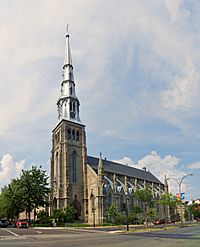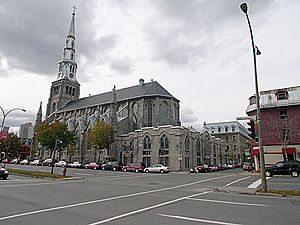Church of Saint-Pierre-Apôtre (Montreal) facts for kids
Quick facts for kids Church of St. Peter the Apostle |
|
|---|---|
|
Église Saint-Pierre-Apôtre
|
|
 |
|
| Location | 120, rue de la Visitation Montreal, Quebec H2L 3B5 |
| Denomination | Catholic Church |
| History | |
| Architecture | |
| Heritage designation | Registered historical site |
| Designated | 5 October 1977 |
| Architect(s) | Victor Bourgeau |
| Architectural type | Neogothic |
| Groundbreaking | 1851 |
| Completed | 1853 |
| Administration | |
| Archdiocese | Montreal |
The Church of St. Peter the Apostle (French: Église Saint-Pierre-Apôtre) is a Roman Catholic church in Montreal, Quebec, Canada. It is located in a neighbourhood called the Village, between Boulevard René Lévesque and Rue Sainte-Catherine East. This church is recognized as a Historic Place of Canada.
Contents
History of the Church
How the Church Began
The land for the church was given by Pierre Beaudry (1774–1848). He owned a large farm in Montreal and wanted a new church built there. The church was named after his patron saint, St. Peter. The Beaudry Métro station is also named after him.
In 1841, a group of priests called the Missionary Oblates of Mary Immaculate came from France. They were invited by Ignace Bourget, who was the Bishop of Montreal. The Oblates settled in the area, which was becoming a busy working-class neighbourhood. They opened a house called Maison Saint-Pierre-Apôtre.
Building the Church
Construction of the church for the Oblate community and local people started in 1850. Father Jean-Fleury Baudrand, O.M.I., was in charge of the project. The church's architect was Victor Bourgeau. He was a famous church architect in Montreal. He also designed the Basilica of Notre-Dame and St. James Cathedral.
Becoming a Parish
For a while, there was a friendly competition between the Oblate Fathers and another group called the Sulpicians. The Sulpicians had set up a parish that included the area where Saint-Pierre-Apôtre was located. This changed in 1900 when Saint-Pierre became its own official parish.
Special Features Today
Today, the church has a special place called the Chapel of Hope (French: Chapelle de l'Espoir). This chapel is dedicated to offering hope and support to people facing serious health challenges. It might be the only chapel of its kind in the world. Every year, the church hosts free organ concerts. It also lights up the church in rainbow colours to celebrate and honor Pride.
Church Architecture
The Church of St. Peter the Apostle is part of a larger group of buildings. This group includes the church itself, the rectory (where the priests live), and the sacristy (where church items are kept). There is also a clock tower and buildings that used to be a choir school and an elementary school.
Inside the Church
The church has three main sections called naves. These sections lead to a rounded area at the end called a polygonal apse. The rectory, built between 1854 and 1856, is as tall as the church. It was built in the neoclassical style, which uses designs inspired by ancient Greek and Roman buildings.
Schools and Decorations
A choir school for boys started in 1859 in a small wooden house on the property. A new building for the choir school was built in 1868. Later, an elementary school was built between 1886 and 1887 to meet the growing need for general education.
The first decorations inside the church might have been done by the architect, Victor Bourgeau. Later, an artist named Guido Nincheri (1885-1973) added more artwork. The church also has a beautiful organ made by Charles Warren. It was later made even bigger by Casavant Frères in 1908. The colorful stained glass windows were made in France by the House of Champigneulle between 1853 and 1883.


